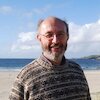In order fully to appreciate his art, it’s essential to understand his life story. Paul hails from England’s Black Country, where his family has roots reaching back to the 1400s. He grew up in a village close to Dudley; other towns in the area include Wolverhampton, Walsall and West Bromwich. As he explains, the area’s name stems from the rapid industrial development that took place during the 18th century, and which came to dominate its landscape and culture. Its transformation was based on rich deposits of coal, iron ore and limestone. Many of the early advances in technology occurred there. As Paul puts it:
…the area turned into a smoky-black polluted landscape that at night was marked by thousands of glowing red furnaces, like volcanos that shards of sparks and fire.
Generations of Paul’s family worked in the mining, iron and steel industries. Growing up was hard in a community that, notwithstanding its strong spirit, was marked by violence. Paul recalls being battered, run over and surviving an attempt at drowning. School was rough, too, each teacher specialising in a particular form of physical punishment. On leaving, he joined his mother in a metal-pressing factory, very much the expected career path among his peers, but it was work that carried serious health risks from chemicals used in the process.















